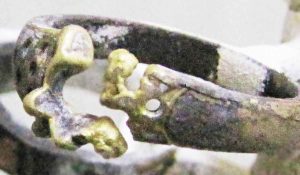★This column is a commentary on lost wax casting with a block molding method
This column has been presented by Yoshida Cast
Casting defects come in various forms, such as cracks in castings, surface roughness and porosity and so on.
Casting defects are classified into several types. And each of these has different causes.
In addition, since the casting process is diverse, the cause may not always be one, and most cases are complicated.
Typical failures are roughly classified into six categories.
First, let's take a look at the causes and countermeasures for "Underfilling (misrun)".
What is casting underfilling (misrun)?
Underfilling is a phenomenon in which melted metal solidifies before completion of filling the mold cavity. It is also called "misrun" in the field terminology such as diecast, ceramic shell casting and sand casting
This casting defect is mainly a phenomenon caused by the temperature of the melted metal and a casting mold.
It is a problem that can be solved by understanding the cause and taking countermeasures.
Why does underfilling (misrun), And what is countermeasure?
Underfilling (misrun) is caused by temperature of melted metal and casting molds during lost wax casting process. Sometimes internal gas would create this problem, too.
Needless to say, it also depends on amount of casting metal. Here are 5 main causes and how to fix them.
CAUSE 1 / Insufficient quantity of casting metal
Occurs when there is insufficient amount of melted metal for a mold cavity.
① Specific gravity of casting alloy is not accurate
If calculation of specific gravity of using casting metal is not accurate, the amount of melted metal may be insufficient or cast metal may flow over a casting mold.
| CALCULATION FOR TOTAL AMOUNT of CASTING METAL (in case of standard injection wax) |
TOTAL QUANTITY OF CASTING METAL = TOTAL WEIGHT for a WAX TREE x SPECIFIC GRAVITY for WAX (1) x SPECIFIC GRAVITY for USING CASTING METAL + SUFFICIENT QUANTITY for BUTTON |
Specific gravity of standard injection wax is 0.98
② Amount of button is underestimated
In the case of casting with precious metals, there are cases that amount for button is reduced to reduce the cost of metal or/and loss of metal. This may cause this defect.
It is recommended to cast once with a sufficient amount of button to check if casting failure occurs.
If the same problem happens even in that case, another cause is conceivable.
③ Wrong weighing of casting metal
There may simply be an error in the weighing.
CAUSE 2 / Insufficient Casting Temperature
① Low Temperature of Casting Metal
Even if metal in a crucible is visually melted, it may not reach the complete melting point.
Alternatively, even if temperature reaches melting point, it may not being reach to proper casting temperature.
In those cases, melting metal solidifies before it reaches to the tip of details of a casting mold.
It is necessary to check the melting point of the using casting metal, also if the temperature of melting metal is proper for designs of the cast. Please remind when shape of casts fine like filigrees or/and thickness is thin, casting temperature should be higher.
If you are doing automatic casting, set the casting temperature higher.

② Low Casting Mold (Flask) Temperature
If temperature of flask itself is too low, it is possible that cast metal will solidify before it reaches the entire casting mold cavity.
Check casting flask temperature of a burn-out furnace. And if necessary, try increasing the casting temperature by 50°C (120 F approx.).
CAUSE 3 / Filling impediment due to back pressure or/and much internal gas
Underfilling will occur if melted metal is poured into a casting mold before the gas existing in the mold or/and the gas that had already contained in casting metal itself has expelled.
Gas is often generated by residue inside the casting mold. Most of residue is often carbide.
There should be problems with temperature and time of burn-out process especially dewaxing stage.
Also, air ventilation of a furnace might be poor.
Complete removal of gas is fundamentally desired.
However, if it is difficult, create air vent sprues as a countermeasure.
Also, as a casting alloy itself may contain a lot of gas, it may be effective to degas the metal before casting.
In general, among metals with a melting point of 1300°C or less, substances with effective deoxidizing effects include silicon, zinc, and phosphorus.
In cases of platinum alloys, let platinum alloy melt in a crucible and solidify once before casting. If there is a bulge in the center of the metal after solidification, there is internal gas. Repeat the same process until the center becomes flat or dented. If the dents cannot be seen during those works, use pure manganese.
In case of stainless-steel case, silicon can be used.
When adding a deoxidizing agent into a casting alloy, mix about 1/1000 to 2/1000 (weight ratio) of the total amount of cast metal.
In pressure casting and vacuum suction casting, the same can happen if casting molds have poor air permeability.

CAUSE 4 / Insufficient over pressure in pressure casting or vacuum suction in vacuum casting
In case of pressure casting, if the settings such as the timing for pressure application or/and volume of pressure is not has been set correctly, this defect will happen.
It is recommended to change parameter settings.
Also, check whether function of a compressor, whether the pipes are clogged or/and leakage of pressure.
In case of vacuum suction casting, check whether the casting mold has adequate permeability.
(Wall thickness of a casting mold, mixing ratio of the investment powder and water, etc.).
Also, check whether function of a vacuum pump, whether the pipes are clogged or/and leakage of vacuum.

CAUSE 5 / Inappropriate wax tree structure
Each casting method, such as pressure casting, vacuum suction casting, and centrifugal casting, has its own casting direction.
Underfilling may occur if the products are mounted in the opposite direction of casting force.
See More details for Ideal wax trees of CENTRIFUGAL CASTING, PRESSURE CASTING, VACUUM SUCTION CASTING
Author : M. Yoshida
Summary of Casting Failure
Countermeasures for underfilling are summarized blow.
Check List
- Recalculation of metal specific gravity/remeasurement of metal amount.
- Increase casting metal temperature and flask temperature.
- Check the set temperature of burn-out furnace and try increasing it by 50°C (120°F).
- Accurately estimate volume for button.
- Well degassing of casting alloy.
- Review pressure settings during casting (pressure and vacuum) or rotation speed settings (centrifugal).
- Ensure casting mold's permeability (Especially pressure casting and vacuum casting).
- Check the status of a vacuum pump or/and a compressor.
- Check shape or/and structure of wax trees.
There is not always one cause. Please review all the items again and see how they work.
When casting condition is desired to be changed, change it one by one.
If you change two conditions at one time, you will not be able to clearly find out an exact and direct cause for the casting error you have.
Author : M. Yoshida
